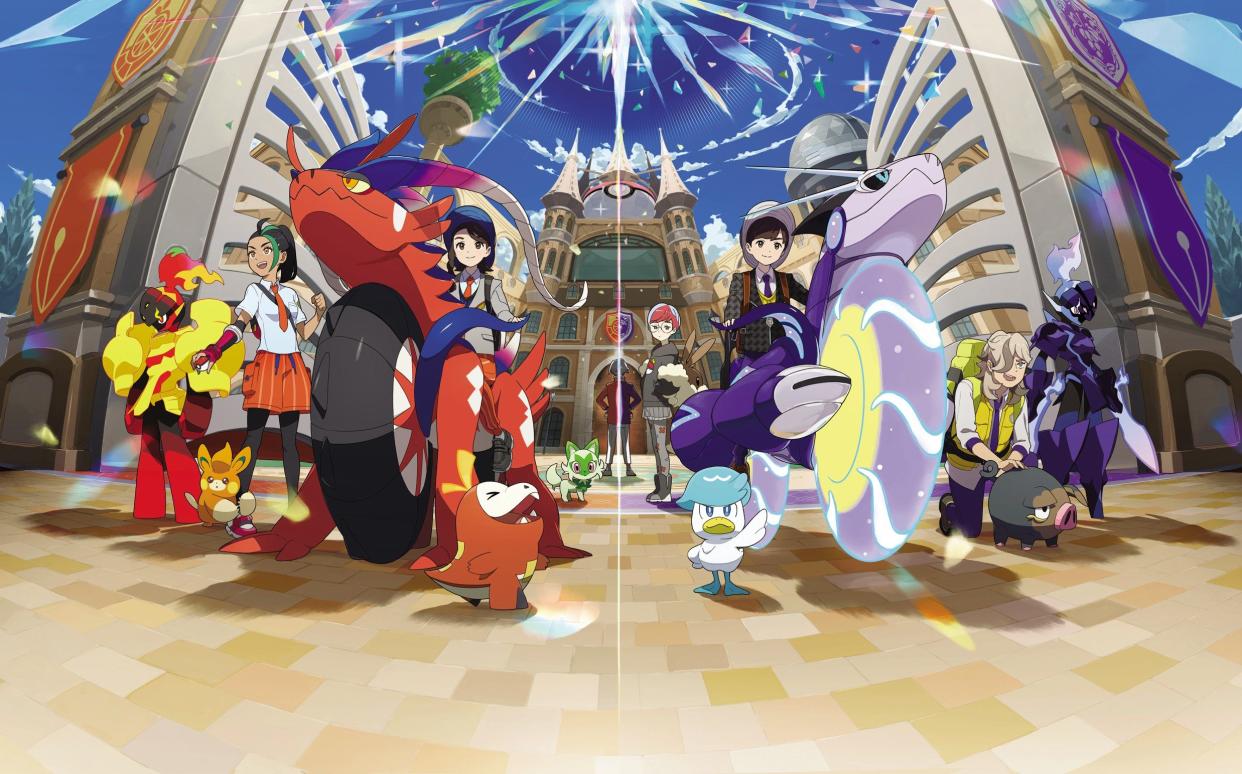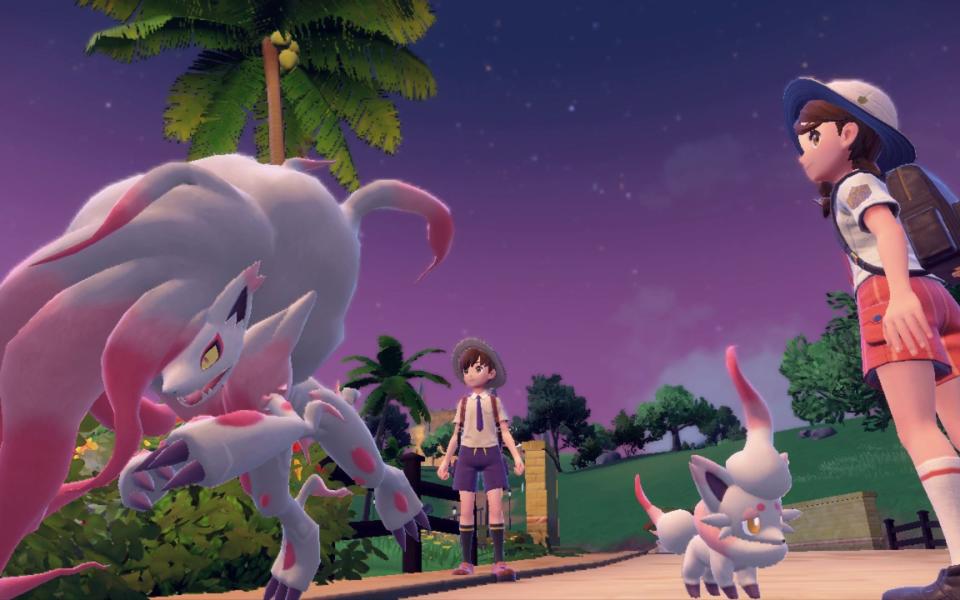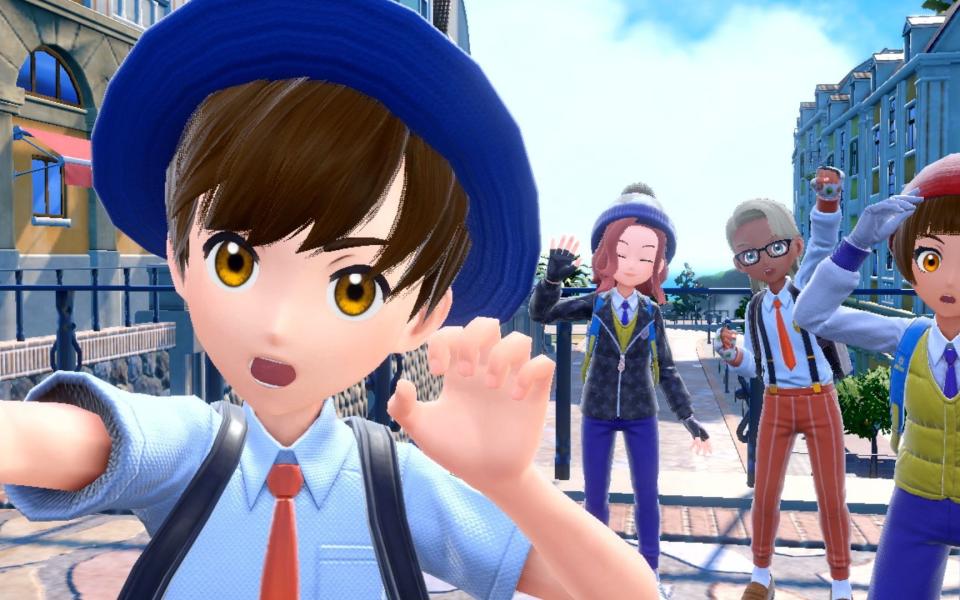Pokémon Scarlet and Violet review: colourful but confusing creature catching

I’m roaring across the countryside of what looks like the Iberian peninsula, wind whipping through my hair as the roar of my motorcycle sends wild hogs and olives scattering in all directions. I screech to a halt before a small pond, already thinking about my picnic luncheon, and observe a group of mud-brown axolotls frollicking in front of me. I switch off my motorcycle’s engine and watch as it transforms back into a robot-panther-dragon hybrid. Yes, that’s right. It can only be the arrival of a brand new Pokémon adventure just in time for Christmas.
After spending three years exploring mountains and rivers of Brit… ahem, I mean Galar, Pikachu and his pals have grown weary of our little island and decided to set off for the sunnier climes of Paldea, a sort of Pokéfied version of Spain and Portugal.
As with every new entry in the series (we’re on the ninth generation of new Pokémon since the originals were first released in 1995) the developers at Game Freak are aiming to reinvent the wheel once again.
Things start in the familiar order of things: you play as a young person who has just moved to the Paldea region with your mother, ready to start your first Pokémon adventure. In a minor twist, this time you’re not simply being turfed out to go and wander the wilderness on your own but have been enrolled in the local boarding school. Of course, you can’t head off to school without a Pokémon pal of your own to keep you company, can you?
This time the choice is between three of the most charming starter Pokémon in generations: Fuecoco, a fat little fire-breathing crocodile/chilli pepper; Sprigatito, a green cat based on an Iberian lynx; and Quaxly, a duck who seems to be taking hair styling tips from Danny in Grease.

Once you’ve picked between those three and been introduced to a new school friend, Nemona, you’re ready to go.
It isn’t a new Pokémon title without a gimmick and this time it’s a doozy: the game is fully open-world. You see something glittering off the path? Go and grab it. See those mountains in the distance? If you can go and climb them if you want to.
Those beloved elemental creatures teem around you, sometimes flocking in herds, sometimes proudly solitary. Each species has its own personality; predatory Pokémon will charge you and make a nuisance of themselves while others flee at the sight of an errant young human skipping across the field towards them.
After a bit of preamble where you’re introduced to the dragon who’ll become your mount (in Violet it is the futuristic robo-panther Miraidon, while those playing Scarlet get the rough, tough gecko-looking Koraidon) and enrolled in school, you’re soon set out on ‘the Treasure Hunt’, an independent study project. While most schools tend to have students typing up essays or doing some performing arts, here you’ll be roaming the country, catching and battling Pokémon, dolling out punishments to truculent students, and seeking treasure.
The first open-world in Pokémon history
This is where the game truly opens up to you. There are three major quest lines: Victory Road, Starfall Street, and the Path Of Legends, and you can take them on in any order or mix and match. Each is a self-contained story arc in and of itself, but all are slightly different spins on the same general formula: go to a place, find the powerful Pokémon or Pokémon trainer, beat them and head onto the next one. If I had to define the differences, I’d largely say that Path Of Legends is generally more action-orientated, Victory Road is more traditional and strategic, and Starfall Street is… well, it’s basically there to force you to use a new mechanic where you send out your Poképals to battle independently.
It’s a fun way to mix-up the formula and it does add a much needed bit of variety to the games, though how much mileage you’ll get out of each of them will vary.

The Path Of Legends storyline was my favourite and might well mark the first time I’ve ever been misty-eyed at a Pokémon game, while Starfall Street is an intriguing mystery which only deepens with new twist and turn. The weakest of the bunch is Victory Road - the standard Pokémon arc which sees you battling eight different gym leaders of increasing strength.
The Pokémon Company have done a good job of keeping a lot of the new creatures under wraps so I was glad to be constantly surrounded by unknown and mysterious Pokémon and had a lot of fun switching up my team as I found new friends who were begging to be a part of it.
The new Pokémon designs are... nice, if occasionally uninspired. I’m prevented from talking about exactly what Pokémon are available, but we’ve already been shown there are at least two new lines based on dogs. And it’s fair to say that the designers have taken the idea of Iberia having the most diverse bird population in Europe and run with it.
Invisible rails
In fact, ‘slightly uninspired’ sums up quite a lot of Pokémon Scarlet and Violet. Try as I might, I couldn’t shake the feeling that it was all just a bit undercooked.
The big talking point of the titles is that they’re open world, but the freedom often feels superficial. Yes, you can climb that enormous mountain in the distance, but don’t expect to find anything interesting when you get up there. Yes, there are huge bustling cities full of people to speak to, but no one will say anything interesting. Yes, there are dozens of intriguing buildings and houses, but you can’t enter any of them.
And while you technically can challenge the gyms, the baddies, and the hulking Titan Pokémon in any order, the world doesn’t scale to fit your level. If you go for one which is meant for the end of the game expect to be sent packing to find an easier one.
The words which constantly came into my head were “illusion of choice”. The game goes out of its way to tell you how free you are to make decisions, but in reality the rails are still here, they’re just invisible now.
The openness often feels like aimlessness. “Just go anywhere, do whatever you want,” says the game, but it punishes players for not following the route it has laid down. Frequently I’d find myself having no idea where to go - not strong enough to tackle the obvious next step, but baffled where to go instead.

In my review of Pokémon Sword and Shield three years ago, I accused the designers of being torn between the series’ past and the present of modern gaming, trying to have their cake and eat it by straddling the two. Here the fence-sitting has become even more pronounced and the splinters are starting to prick.
Even on a technical level, Scarlet and Violet struggle in ways that I’ve never seen in a Pokémon title before. Even after installing a stability patch my game crashed three times in various different places for no obvious reason. I found multiple items which couldn’t be picked up, slipped through solid walls, got stuck in positions which I could only escape by turning my console off, and encountered more visual glitches than I can describe.
No doubt there’s a lot to love here. I haven’t even mentioned Terastallizing which turns your Pokémon all sparkly and changes their type, a new battle gimmick which has the chance to transform the metagame forever. The sandwich making mini-game is endlessly adorable. The majority of the new Pokémon designs are fun and interesting. There’s four-player co-op so you can hang out with friends in the world of Pokémon.
Unfortunately though, I have continually felt like I’m fighting against Pokémon Scarlet and Violet. I am straining to see the positives while the game continually denies me. Perhaps, like Sword and Shield before them, Scarlet and Violet will receive some redemptive DLC, but for now they feel like they’re stumbling over the cusp of brilliance, throwing a dozen things at the wall and finding nothing sticks.


